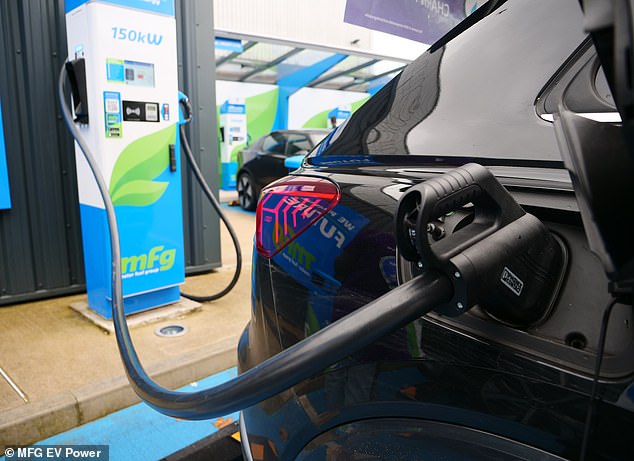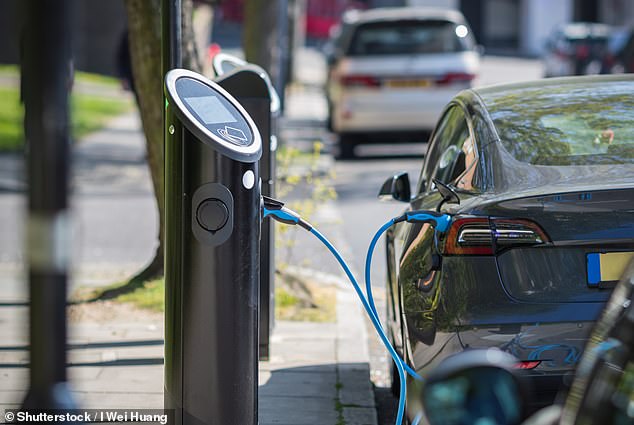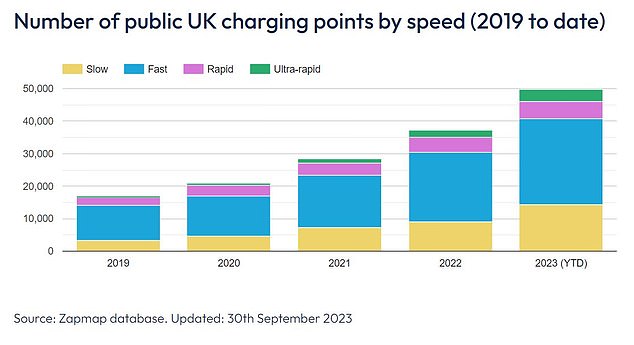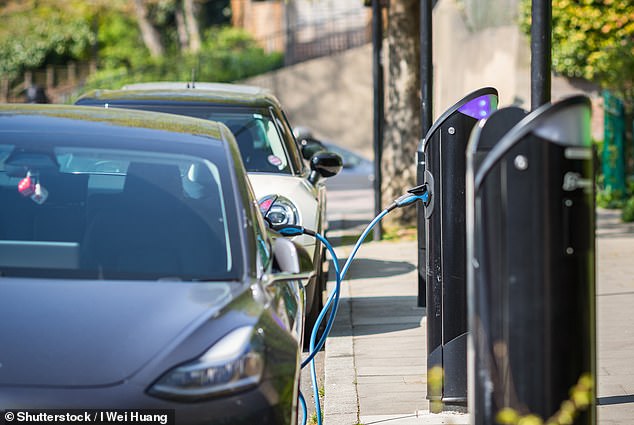Britain hits milestone 50,000th public EV charging point installation – with six years left to meet 300,000 target
Britain now has more than 50,000 public electric vehicle (EV) charging points for the first time, official figures used by the government confirmed today.
Weston-super-Mare is the location for the “cornerstone” device installed last month, according to the company, which provides data on charging infrastructure to the Department for Transport.
Zapmap says the current trajectory should lead to the addition of the 100,000th EV charger within the next two years. However, installations will need to grow much faster to meet the ambitious targets set by ministers.
British drivers have been promised there will be more than 300,000 public chargers across the country by 2030, leaving just over six years to add a further 250,000 devices to the road network.

‘Milestone’ EV charger: The 50,000th public charger was installed in the UK last month. It was an ultra-fast charger (similar to the one pictured) at MFG EV Power’s center near Weston-super-Mare, Zapmap confirmed
The 50,000th charging point is an ultra-fast MFG EV Power device installed at a gas station near the southwest coastal city in October.
The milestone comes eight months after the UK’s 40,000th public EV charger was added in February.
And the next milestone of 100,000 devices is expected to arrive in August 2025, based on Zapmap’s calculations.
Industry commentators say the rate of deployment of charging points is increasing, with the network expanding by 43 per cent in the past 12 months.
However, reaching the target of 100,000 devices by the summer of 2025 will require an average of 2,273 new devices installed in each of the 22 months leading up to that date, while only 1,432 were added in September.
That means current monthly installs should grow an average of 60 percent between now and August 2025.

Zapmap, which provides the DfT’s charging infrastructure numbers, estimates that the 100,000th public device will be installed in August 2025. However, for this to happen, monthly installations would need to grow by 60%

Ministers had previously set an ambitious target of having 300,000 public chargers in the UK by 2030. However, Rishi Sunak’s recent decision to delay the ban on the sale of new petrol and diesel cars by 5 years until 2035 could brought about this change
The report comes after Prime Minister Rishi Sunak’s decision to slow the transition to electric cars by delaying the deadline to ban sales of new petrol and diesel cars by five years from 2030 to 2035.
It remains unclear whether delaying this ban will affect the government’s existing goals to strengthen the nation’s charging infrastructure.
Last year the DfT announced it would spend £1.6bn building a network of 300,000 EV chargers by 2030 as part of its Electric Vehicle Infrastructure Strategy.

If that goal remains, just 74 months remain to add just over 250,000 devices to the network.
At the end of September, there were 49,882 electric vehicle charging points in the UK, Zapmap says.
To add another 250,118 between now and the end of the decade would require an average of 3,380 monthly installations — a 136 percent increase over the volume of devices added to the network last month.
However, Zapmap remains optimistic that the country is on track to deliver enough public chargers to cater for Britain’s growing number of EV drivers.
Last week, the company’s quarterly statistics showed that the number of the UK’s fastest ‘ultra-fast’ charging points has increased by 68 per cent since September 2022, while the number of slow chargers has grown by almost the same amount.

This is the breakdown of the different devices available on the public network right now. Ultrafast devices are the fastest and can charge a battery from 10-80% in less than half an hour

Industry commentators believe the UK is on course to accelerate the number of public chargers available across the country, although they admit they are currently adding them in areas where there is the highest demand based on the number of local owners
Melanie Shafflebotham, co-founder of Zapmap, said: “Achieving 50,000 public charging devices is a really important milestone for the country and illustrates the sea change behind the increased rate of charging point installations.
“Having passed 40,000 charging points in February, our projections are that there will be 100,000 chargers by August 2025 – which would certainly be a great achievement.
“Along with the number of high-power charging centers in the UK more than doubling since last year, as we saw last week, these are changes that bring real benefits to electric car drivers across the country.”
Although more devices are being added, there are ongoing concerns about the uneven distribution of their availability.
A recent report by the County Councils Network found that EV owners in rural England have to drive thirteen times further than drivers in London for a charging point.
It says rural counties have just one electric car charger every ten miles of road, compared to one every three-quarters of a mile in the capital.
However, those living in the countryside are much more likely to be able to install a home charger on their property than those living in flats and houses without off-street parking in the capital.
This means that people living in rural areas rely much less on the public grid.
Ian Johnson, chair of the ChargeUK campaign calling for more government support to speed up charging infrastructure, says the rate of deployment is increasing all the time with a focus on the areas of the country that need it most.
“In the last 12 months alone, the network of public charging points has increased by 43 percent,” he said.
“However, we can go further and faster with the right policies and government help to remove the barriers that limit deployment.
“Public chargers are part of a bigger picture. How people charge their EVs depends on their lifestyle, many people charge at home, others on the street, while many people will charge either at their destinations or during their journey.
“Our members are focused on ensuring drivers have access to the right charger in the right place.”
VIDEO

VIDEO ABOUT ELECTRIC CARS
Some links in this article may be affiliate links. If you click on them, we may earn a small commission. This helps us fund This Is Money and keep them free to use. We do not write articles to promote products. We do not allow any commercial relationship to affect our editorial independence.
